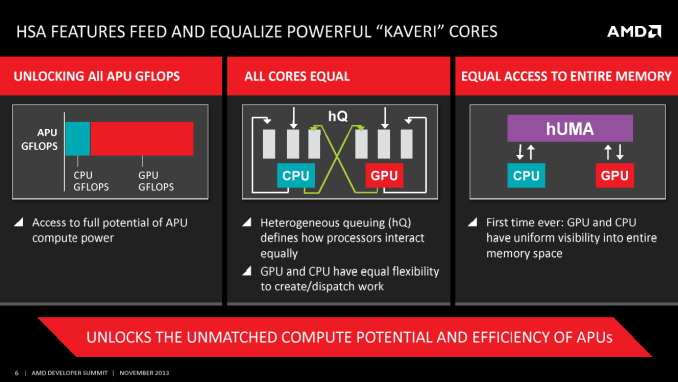AMD Corporate Fellow Phil Rogers Leaves Company, Joins NVIDIA
by Ryan Smith on October 13, 2015 7:35 PM EST
With respect to both structure and personnel, the last few months have been busy – if not tumultuous – for AMD. The company recently reorganized itself so that their graphics division and its employees are once again a whole entity under Raja Koduri as the Radeon Technologies Group, as opposed to being dispersed among AMD’s various technical and organizational groups. Meanwhile on the personnel front, last month AMD ace CPU architect Jim Keller stepped away from the company after completing his work on Zen. As it turns out, Jim is not the only recent high-profile departure from AMD; as discovered by HardOCP today and since confirmed by AMD, AMD Corporate Fellow Phil Rogers has left the company as well.
As one of AMD’s high-ranking technology & engineering corporate fellows, Rogers’ held an important position at AMD. For the last several years, Rogers has been responsible for helping to develop the software ecosystem behind AMD’s heterogeneous computing products and the Heterogeneous System Architecture. As a result, Rogers has straddled the line as a public figure for AMD; in his position at AMD Rogers was very active on the software development and evangelism side, frequently presenting the latest HSA tech and announcements for AMD at keynotes and conferences.
Consequently, though by no means the only person working on the software side of HSA at AMD, Rogers’ role in its development is an important one. Along with serving as a corporate fellow at AMD, Rogers was also a major contributor to the HSA Foundation, helping to initially found it in 2012 and serving as the Foundation’s president until he left AMD earlier this quarter. So if there is any one person at AMD that could have been classified as the face of HSA at AMD, then Phil Rogers would have been it.
Given his position within AMD, both on HSA development and as one of a small number of technology fellows (the highest technical rank within AMD), Rogers’ departure comes as a bit of a surprise. Prior to leaving the company, Rogers’ had been with AMD (and ATI before it) for 21 years, serving as a fellow for the last 8 of those years. AMD for their part isn’t saying much on Rogers’ departure beyond confirming that he left earlier in the quarter, however it should be noted that the company is currently in its “quiet period” before their Q3 earnings release on the 15th, which typically prevents companies from discussing personnel changes such as these.
From an HSA development standpoint Rogers’ departure comes at an interesting time. On the one hand HSA is still in its infancy, with the software ecosystem still being built up and AMD just now shipping their first full HSA 1.0 capable APUs with Carrizo. On the other hand the HSA Foundation did finish the HSA 1.0 Final specification earlier this year, and some of the other foundation members have announced that they’ll have HSA-capable designs available in the near future, so the initial work on HSA is done. In which case similar to Jim Keller this may be an AMD employee leaving now that they’ve accomplished their key technical tasks.
Meanwhile of equal interest is where Rogers has landed: AMD’s arch-rival NVIDIA. According to his LinkedIn profile Phil Rogers is now NVIDIA’s “Chief Software Architect – Compute Server” a position that sounds very similar to what he was doing over at AMD. NVIDIA is not a member of the HSA Foundation, but they are currently gearing up for the launch of the Pascal GPU family, which has some features that overlap well with Phil Rogers’ expertise. Pascal’s NVLink CPU & GPU interconnect would allow tightly coupled heterogonous computing similar to what AMD has been working on, so for NVIDIA to bring over a heterogeneous compute specialist makes a great deal of sense for the company. And similarly for Rogers, in leaving AMD, NVIDIA is the most logical place for him to go.
Wrapping things up, we may yet hear a bit more about Phil Rogers’ departure from AMD on the earnings call on the 15th. Otherwise it looks like it will be AMD’s Gregory Stoner who will be stepping up to the plate to replace Rogers. Stoner is AMD’s current Senior Director of Compute Solutions Technology and long-time Vice President of the HSA Foundation, and with Rogers’ change in employment he is now the managing director of the Foundation as well.
Source: HardOCP












83 Comments
View All Comments
medi03 - Thursday, October 15, 2015 - link
Jim Keller doesn't count. Finish project then leave is what he always does, no matter where he works.RussianSensation - Thursday, October 15, 2015 - link
They don't like logical responses since it goes against the mantra that AMD is bankrupt any day now.hammer256 - Tuesday, October 13, 2015 - link
I really don't want to jump to any conclusions until the 15th...I think if they execute well on their next iteration of GPUs and CPUs, they should be in a reasonably competitive shape...
extide - Tuesday, October 13, 2015 - link
One can only hope...JoeMonco - Tuesday, October 13, 2015 - link
Sure, people have said that for every new line of CPUs and GPUs. How many times must you go through this game before seeing the writing on the wall?AS118 - Wednesday, October 14, 2015 - link
While I would have agreed with you in the past (Bulldozer was too big of a risk and they really shouldn't have dropped the ball on single-core performance) Jim Keller designed the next CPU, and he was on board the last time AMD made a competitive processor.As for the GPU's, HBM + process shrink + Raja Koduri being in charge just might make things better. I can only hope, honestly. I don't want a x86 or dGPU monopoly. The only way I can see things continuing if AMD fails is if Intel started making Video cards, and Nvidia bought out AMD and started making x86 CPU's or whatnot.
Or well, someone buying somebody (probably AMD) and finding a way to make sure dGPU's and x86 CPU's are still a 2-horse race somehow.
ThreeDee912 - Tuesday, October 13, 2015 - link
Zen is basically AMD's last hope. If it doesn't pan out, there's not much left to carry them. The GPUs are still somewhat competitive, but right now AMD's in a bit of a lull with no real new products while Zen is still getting ready for production.coburn_c - Tuesday, October 13, 2015 - link
Pfft. So crappy that all you sheep bought your 2500k then started going oh poor AMD... You put them out of business and then realize it's a bad thing... Lovely.SilthDraeth - Tuesday, October 13, 2015 - link
I've been buying AMD since I built my first computer 18 years ago. Performance has always been good enough. And hell back then, when the first Athlons came out, and AMD started x64, and I ran Windows XP x64 edition, AMD was actually superior to Intel. In fact, they where the first real threat. I firmly believe had Intel not engaged in anti competitive behavior back then, essentially locking AMD out of companies like Dell, and HP back then, AMD would have had a lot more market share, and income, and today would be a very different day, than wondering if AMD is about to go bankrupt.Gigaplex - Tuesday, October 13, 2015 - link
The illegal actions from Intel definitely did set AMD back, but even if that didn't happen, AMD would have struggled to produce enough chips to meet demand as their production capacity was only a fraction of Intels. The fact that the Core architecture from Intel was such an improvement, and AMDs Bulldozer was a bad design from the start, suggests AMD may not have fared all that much better.